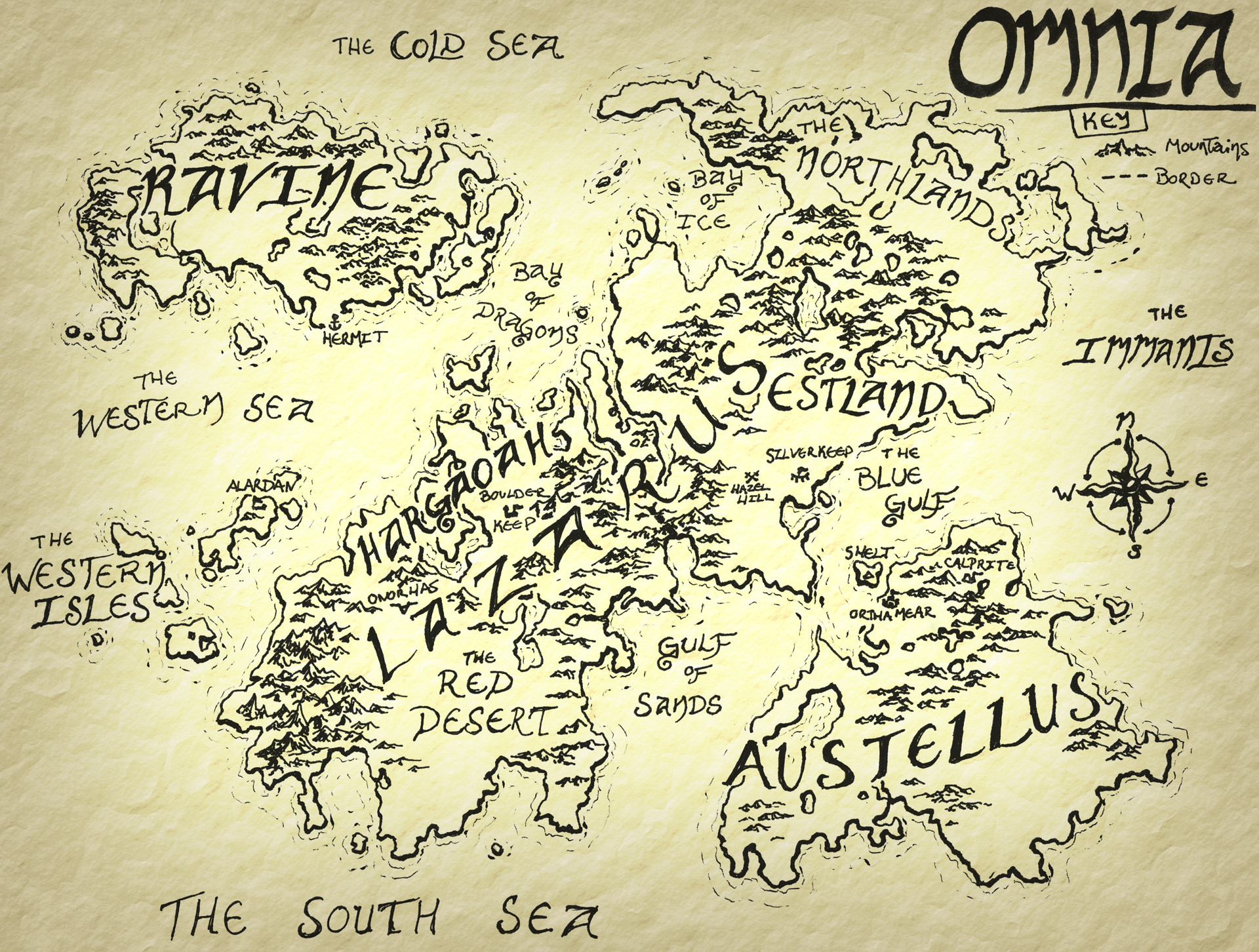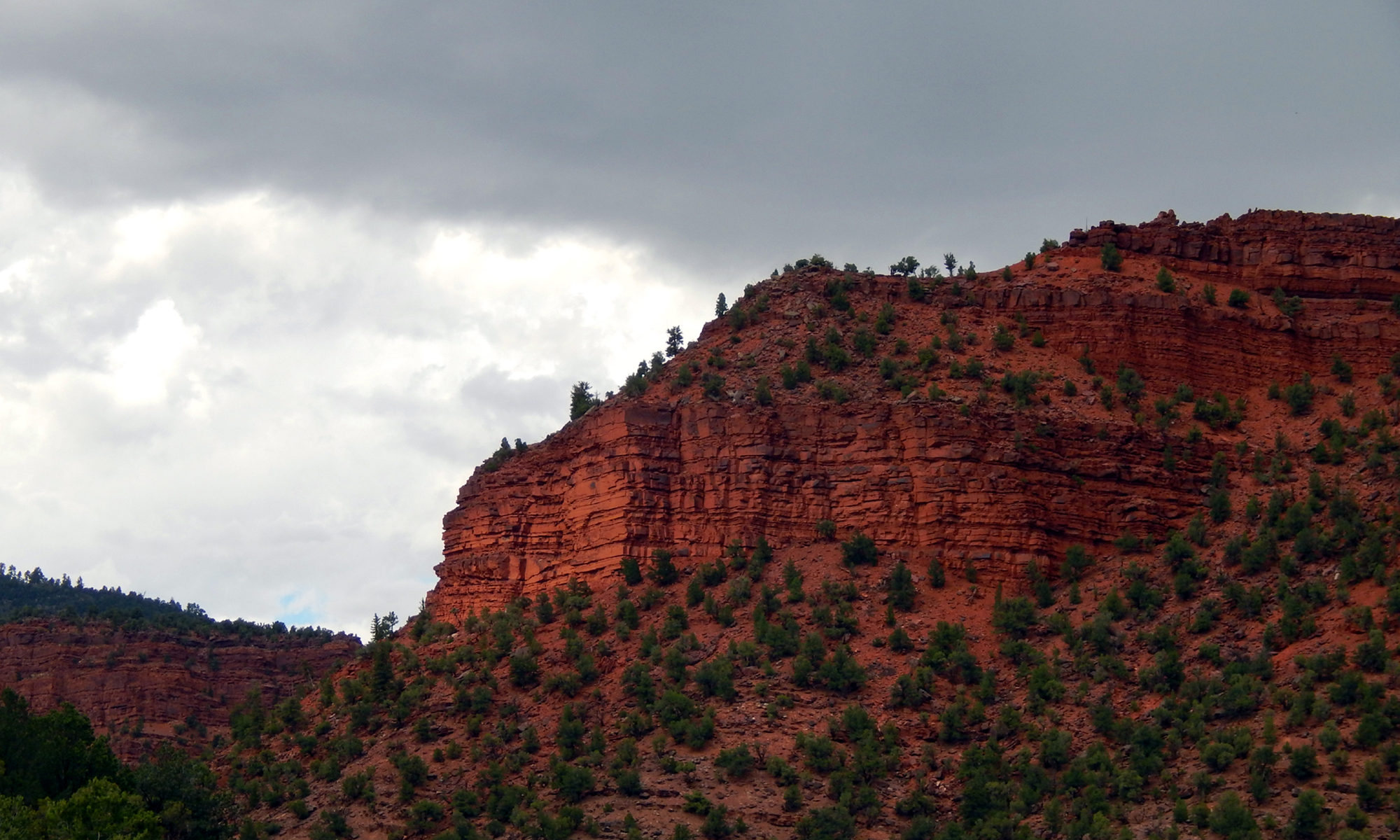
Synopsis
Omnia. The Mortal Realm, the Harmonic Realm, where any and all beings from any realm can co-exist relatively peacefully. It has a balance of the energies from all other realms, and so naturally exists in the center of the energetic cosmos. The beings who live here naturally have limited lifespans, the shortest of which belong to the Beastfolk. The most widely spoken languages in the established world are Estlandic, a linguistic descendant of Empyrean, and Gaoan, which is older than any other language in the Realm. All gods hold sway over this land, some more than others, as a measure to keep the energy of the Mortal Realm truly balanced.
Lands
-
Lazarus:
The land first conquered by the Empyreans, the first ancient empire, who gave it and the surrounding lands their contemporary names. Lazarus spans from the arctic circle down to almost the equator, in one long, relatively thin, mass of land. It is populated by all manner of folk, and is home to two Kingdoms: Estland and the Empire of Stones (or Hargaoah), and three Territories: the Western Isles, the Northlands, and the Red Desert. The fauna of Lazarus is generally small, compared to that of other Realms anyway, consisting of birds of prey, herd mammals like elk, deer, and horses, bears, a few species of large cat, and the occasional wyvern.
-
Austellus:
The “paradise” continent. Because of its location and history, Austellus is one of the most geologically, meteorologically, and socio-economically stable places in Omnia. It has kept its Empyrean name over the millennia, but has yet to be conquered by any kingdom, though it has been settled. It is treated as a kind of neutral territory, and has only ever come under serious threat, and nearly destroyed, once. It is host to a wide variety of songbirds, big cats, horned mammals like gazelle and antelope, and – in the southern reaches – species of crocodile and alligator.
-
Ravine:
Named for Riven, Demon King of the North, who, in 2E 257 covered the land in Scourge, which initiated the 66 year long Lazarus War. Originally called Boreas, by the ancient Boreans, it is a cold land of ancient mountains and evergreen forests northwest of Lazarus. After the Undoing, it has become a wildly contested land, as the hills and mountains are rich in metals and gems. Its original fauna boasted a wide array of hardy animals, like aurochs, sheep, long-haired horses, and bears, but the ecosystem has since changed. The first species to return to Ravine were birds, especially mountain songbirds, birds of prey, and scavengers like ravens and crows. Many species have since begun migrating to Ravine over the winters, when the ice can reach up into the arctic circle, making paths between Ravine, Lazarus and who knows where else. Wolves, bears, and mammoths have been the most opportunistic of this new place.
-
Hargulad and the Hyperion Islands:
It is rumored that somewhere out to the west in the South Sea, there are a chain of Islands where the stone is rich blue and the trees stay broad-leaved and green all year round. Those islands are called Teo-Tahl by the locals, and have been mapped extensively by one intrepid cartographer. On the other side of the world, out somewhere in the Immanis, there is another land rumored to exist, from far back in Empyrean legend. A land several times the size of Lazarus and the surrounding landmasses combined. Nobody knows if this place, called Hargulad in Gaoan myth, is actually real, but with the discovery of Teo-Tahl, some are looking hopefully to the east.
Countries
-
Estland:
Autocratic Monarchy, ruled by the King or Queen, who presides in Silverkeep, the capital. The kingdom was founded by Diamant Silverkin, and the crown has passed down the line until Xankul’s bastard son Jay Thursmund, the Phoenix King, took the throne, by virtue of his heroic acts against Riven in the Undead War. Estland is 225 years old and has had a total of five Kings.
Estland is populated mostly by humans, and the most commonly spoken language is Estlandic. People who come from Estland – usually those who are brown of hair and ruddy of skin – are called Estons.
-
The Empire of Stones (Hargaoah)
Oligarchic Monarchy, ruled by an Emperor, or Empress, who has gone through intense and specific training and instruction as to how and why things work in the Empire. The process of choosing a monarch begins with a circle of Oracles, who seek children with the gift of leadership, and ask their parents if they would let that child go into the education system, in preparation to perhaps become the next monarch. There is also a council, made of representatives from each of the guilds, who have the power to veto bad decisions, and even dethrone the monarch, but only with a unanimous vote.
Some of the guilds include Farmers, Merchants, Architects, Tailors, Artists, Fighters, Mages, Hunters, and Scholars, among others. The Shadows(thieves and spies), are actually sanctioned by the Empire, and only operate outside of it. They act as an information network, and the head of the Shadow Guild is generally the speaker for the council. In times of war or impending unease, the Shadow Guild can also act as a sabotage network.
Hargaoah mostly consists of Gaoans, and is usually ruled by a Gaoan. The language most often spoken is actually Estlandic, among the common folk, and Gaoan, among the councils. People from the Empire are called Hargaozi, and the capital is Har Aradace, known to outsiders as Boulder Keep.
The current ruler is Empress Ukuna, a Gaoan with flashing gray eyes, black hair, and skin the color of metamorphic rock. She is also known as Ukuna, the Lady of Steel.
-
Ravine
Ravine was formerly known as Boreas, and, before Riven decimated it, was a thriving civilization that rivaled even Empyrea, and indeed even went to war to defend itself against them. The so-called Dragon Sea War lasted only three years, after which the High King of Empyrea decided it wasn’t worth the wasted resources. Boreas was ruled by a High King too, as well as a collection of regional lords. They had the largest navy in the world, at one point, and some say they even sailed as far as Hargulad in their height of power. However, after it became Ravine, is is now beginning to be re-settled, and has no central seat of power. Some folk are taking to Ravine as an escape from the ways of their home countries – most often from Estland – and as such are more than willing to fight to defend their freedoms, echoing the original spirit of Boreas.
-
The Western Isles
Once just a collection of separate nation-states, as of the end of Winterdream it has become a united Republic under the rule of Regent Terestai Dwin’Ervis, whose brother, Caunion, acts as Ambassador. Each of the isles elects representatives who deal with the larger issues like foreign affairs, and a code of laws governs all of them. However, they run their own business amongst themselves, have their own names, and even their own internalized governments, which the Regent doesn’t interfere with unless it’s strictly necessary. It is a very new country, and is still in the throes of trying to figure itself out.
People from the Western Isles are generally called Westerners, or Islanders. They speak a collection of languages, but most commonly Estlandic. While they are currently “ruled” by an Elf, the vast majority of people here are humans, and half-breeds. The capital of the Isles is Alardan, and Alardan Keep.
People
The native races of Omnia are, as a collective, called True Mortals. This includes Gaoans, Humans, Pebblefolk, Merfolk, and Beastfolk. Generally, these races do not intermix with the other True-Mortals (in fact doing so is, in many cultures, considered taboo), though they do sometimes produce offspring with races from other Realms.
- Gaoans, or Stonefolk, stand roughly 6 to 8 feet tall, are built thick and bulky, and have striated, mineral-rich skin that seems to mimic layers of stone, which comes in various shades from chalk white to jet black, ranging through dull reds, yellows, browns, and sometimes blues and greens. They are the longest-lived of any True Mortal race, with the average life expectancy being 180.
- Pebblefolk are genetic cousins of the Gaoans, standing from 3 to 5 feet tall, with the roughly the same variations of skin and hair color. They tend to have slightly bigger ears relative to head size, as well as slightly larger eyes, and they normally lack striation in the skin. They live only slightly longer than humans, with a life expectancy of 90 years.
- Humans, or Plainsfolk, are generally referred to as what happened to the Mortals who weren’t changed by the various gods and lands and magics. They stand about 5 to 6 1/2 feet tall, with skin that ranges from pale to dark, in varying shades of brown, and hair that ranges from white to black, with various shades and permutations of brown, gold, and red in between. The average life expectancy of a human is 65 years, assuming stable living conditions. Humans are also the race that interbreeds with other races the most often.
- “Beastfolk” is an umbrella term to describe the races that resemble non-sapient land animals. Many of these races grow hair, scales, or sometimes feathers all over their bodies, and have other attributes, like claws, ears, tails, and eyes, that further link them to their bestial counterparts. The individual races are often named after the animal type that they most closely resemble, for instance “Foxfolk,” “Catfolk,” and “Snakefolk,” though this is not the case with Fauns. They do have their own names as well, for instance, Nagas for the Snakefolk, and Huldras for the Foxfolk. They live the shortest of any True Mortal race, perhaps because of the conditions in which most of them live. Average life for a Beastfolk is roughly 40 years.
- “Merfolk” is another umbrella term, but this one is used to describe the water-dwelling races of Omnia, which are often lumped together under the same name by the land-dwellers. They generally all have some array of fins, gills, scales, and occasionally lack any body hair. Merfolk are the least likely of any race to breed with any other, mostly because of the difficulties involved in doing so. They have an average lifespan of 100 years, and have adapted to suit many marine environments, from freshwater to salt, tropical to arctic.
There are races in Omnia that are not originally from Omnia, since the realm is one that supports almost all life. They are also called Mortals, since they also have limited lifespans, and are prominent in the various cultures of the world. However, being non-native, they are not True Mortals, and do not see any wrong in breeding amongst themselves – outside of cultural morality, anyway. These other races include but aren’t limited to: Elves, Dark-Elves, Demon-kin, and Dragon-kin.
Undead, while technically native to Omnia, do not have limited lifespans, and so are not technically Mortal. The most well-known varieties of Omnian Undead include Vampires, Litches, Banshees, Ghouls, and Revenants. Scourge-spawn were once on that list, but after the Undoing, there are now no Scourge-spawn anywhere in the Realm. Werewolves and other shape-changers also exist on Omnia, but because they are created from other races, like Undead, they’re more of a condition than an actual people unto themselves.
Thank you for being here for this overview of the Realm of Omnia! Next week we’ll be taking a look at Liserna, which is more than just the land of the dead. Hope to see you then!
-E.J.

